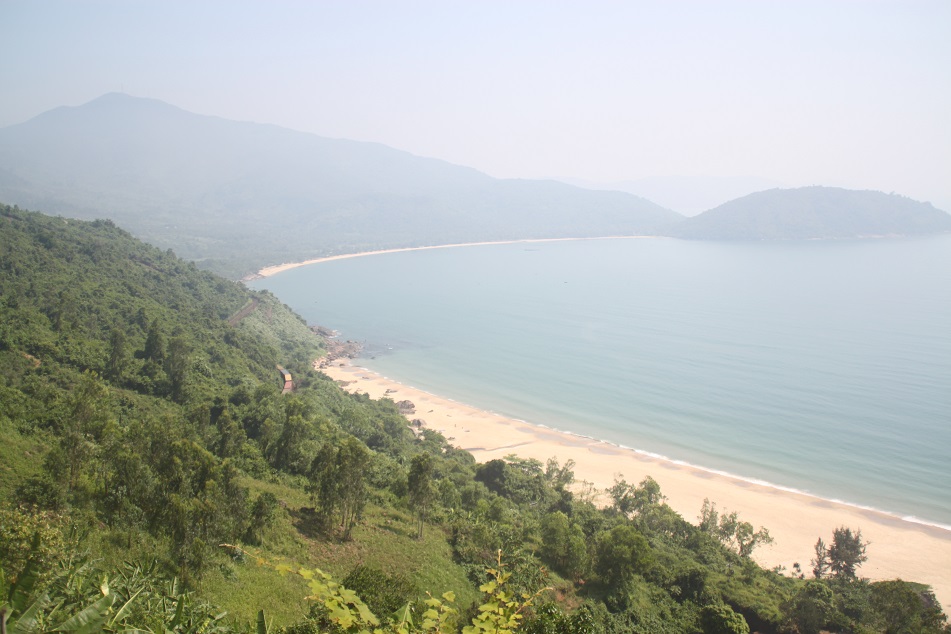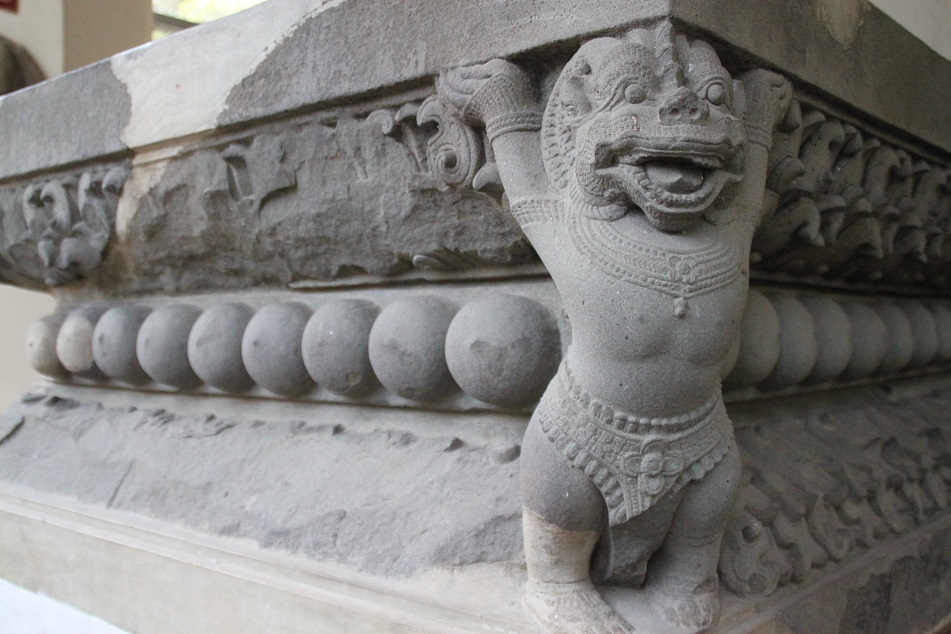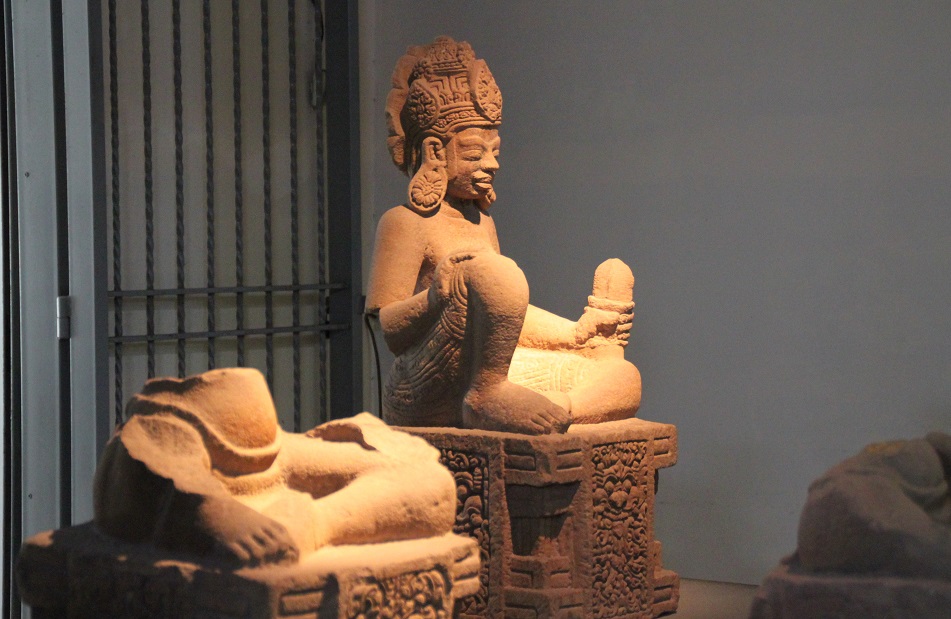For centuries, the mountainous region of modern-day central Vietnam was a natural border separating the land of the Cham people in the south from that of Dai Viet to the north. With towering peaks that soar from the country’s interior all the way to the coast, the role of this formidable natural fortress is similar to the Pyrenees for Spain and France, and the Himalayas for China and India. On both sides of the border, different customs and religions developed almost independently from each other, although cultural exchanges did occur to some extent.
Unlike Dai Viet whose culture was heavily influenced by China, in Champa – the land ruled by the Chams – Hinduism and Buddhism flourished. Like other Hindu-Buddhist kingdoms in Southeast Asia who left their legacies in the form of magnificent temples, the Chams also erected monumental shrines decorated with ornate carvings and beautiful statues created by the finest Cham artisans. Among them, My Son was arguably the most important religious center in Champa, indicated by the high concentration of temples in the sprawling complex built by different rulers over the centuries.
Similar to the arrival of Hinduism to Champa from land and sea, Buddhism also reached the Chams through the same routes as early as the fifth century. Archaeological excavations in the region further discovered artifacts related to Buddhism, bearing a resemblance to those found in modern-day Sri Lanka, India, Myanmar, Thailand and Java. When a new king, Jaya Indravarman, came to power in the late ninth century, Buddhism became the official religion of the kingdom and construction of Buddhist temples in Champa began in earnest. An inscription records the diplomatic missions of a Cham minister to Java, at that time an important intellectual and religious center in the region. Upon his return, he commissioned two temples: one for Shiva (a principal deity in Hinduism), the other for Avalokiteśvara (the embodiment of the compassion of all Buddhas). This signified the syncretic nature of the religions practiced in Champa at that time.
At the heart of his capital, Indrapura, King Jaya Indravarman enlarged an existing Buddhist temple and added ornate relief panels as well as finely-sculpted statues which rendered the royal temple compound a grand look. Buddhism enjoyed a large following in Champa for centuries, regardless of the political upheavals within the kingdom and conflicts with its neighbors. By the 13th century, a syncretism of Hinduism and Buddhism became more evident with the profusion of temples dedicated to both Shiva and the Buddha. This followed a similar trend in Java where aspects of Shaivism (the worship of Shiva) and Buddhism were fused to form a concept of Shiva-Buddha, although Buddhism remained secondary.
Centuries later, as the power of Champa crumbled and the Viet advanced to the south, many Cham temples were abandoned, leaving nature to slowly reclaim them. The former royal temple of the Buddhist court of Indrapura came into the spotlight again after it was discovered by Henri Parmentier and Charles Carpeaux in the early 20th century when Vietnam was under French control. A drawing made by Parmentier himself revealed the highly-intricate embellishments of a pedestal in the main shrine. Dubbed the Dong Duong monastery, after a small town where it was excavated, the entire compound was almost completely destroyed by the indiscriminate air raids during the Vietnam War – the same war that caused major destruction to My Son, 20 km to the north of Dong Duong.
What could be salvaged from the war is now safely housed at the Museum of Cham Sculpture in the city of Da Nang. Built in the early 20th century as the Musée Henri Parmentier, named after the esteemed French archaeologist for his contribution to preserving Vietnam’s cultural heritage, the museum has been showcasing the finest Cham sculptures and reliefs since its inception. A visit to the museum is like stepping back in time to the glory days of Champa, thanks to the celebration of Cham craftsmanship which created such beautiful and impressive works of art. A section of the museum is filled with statues of beasts, including a dragon indicating historical cultural exchanges between the Chams and the Viet. One small pedestal is embellished with sculpted breasts – similar to the Batak sculptures on Samosir in Indonesia. Meanwhile, a statue of Shiva shows a distinctively Cham character, quite different from how the god is usually depicted in Java and the Indian subcontinent. Some of the most impressive artifacts of the museum are displayed in the inner hall with a high ceiling. Intricately-carved statues, pedestals, temple walls, and stairs from Dong Duong are all a testament to the artistic achievement of the Chams, as well as a grim reminder of the war which almost laid waste to what was once a magnificent Buddhist monastery.

















Melihat peninggalan dinasti Champa ada banyak kemiripan relief dengan candi-candi Singasari di Malang. Jadi pingin napak tilas Indrawarman yang dikisahkan pernah diungsikan di Java. Peradaban yang sambung-menyambung di sisi tenggara Asia. 🙂
LikeLiked by 1 person
Dan dari sisi sinkretisme agama Hindu dengan Buddha terutama pada masa Indrapura pun mirip dengan praktik yang sama di Singasari, meskipun mungkin ada detil yang berbeda di antara keduanya. Memang seru ya menelisik candi-candi di Asia Tenggara yang secara langsung maupun tidak langsung memiliki keterkaitan satu sama lain, terutama candi-candi Champa dan Jawa.
LikeLike
Seems I missed an important historical site on my visit though I must admit, I’m not as enthusiastic about temples as you appear to be.
I do like Vietnam’s take on the “Vietnam” War though because it really was the American war.
LikeLike
It’s a small museum, so people might not notice this building from the street. You can always return to Da Nang, Mallee, and visit this museum if you have ample time in the city. You’re right about my penchant for ancient temples, so much so a few months ago when I read about the invention of a new durable material for construction I immediately thought “it would be perfect to build a temple!” 😀
LikeLiked by 1 person
Got to know some history! 🙂 Informative.
LikeLike
Glad this post enlightened you with some information about this ancient kingdom, Sruthi.
LikeLiked by 1 person
Thank you for the post 😀
LikeLike
And thank you for reading!
LikeLiked by 1 person
Bagus banget post nya! sebelum baca tulisannya, saya pikir itu relif candi indonesia.
LikeLike
Terima kasih ya sudah mampir dan menyempatkan untuk membaca. Kerajaan Champa memang di masa lalu memiliki hubungan dengan beberapa kerajaan di Jawa, jadi beberapa relief di Champa dan Jawa memang ada kesamaan.
LikeLike
Just stunning!
LikeLike
For whatever left from the once mighty kingdom, they do still impress people centuries after they were first built or made. Thanks for reading!
LikeLike
Your words and photos always give an excellent peek into the past, and the continuous rise and fall of religions, dynasties, and cultures. I’m glad that at least some of the statuary and temples survived the US onslaught so that local people and the rest of us can learn and appreciate their accomplishments and failures. Thanks!
LikeLike
You’re so kind, Marilyn. Thanks for reading, and yes, basically the patterns keep repeating as more kingdoms and empires rise and fall over the course of millennia. If you look up Dong Duong on Google, you’ll see what have been lost forever — numerous centuries-old temples and shrines. However, the fact that some of the artifacts survived the war relatively unscathed must have been a huge relief for scholars, historians, the Vietnamese people, and the international community. At least today we can learn a thing or two about this magnificent civilization from the past. Thanks for reading and sharing your thoughts, Marilyn!
LikeLike
Wow! What an interesting and enlightened article of a little known cultural heritage of a region in Vietnam! Your text and photos were equally impressive. Thank you for sharing your knowledge with us!
LikeLike
Glad you enjoyed this post, Peter! I’m equally delighted to share with you and others about the magnificent craftsmanship that created those impressive statues and relief carvings.
LikeLiked by 1 person
I’m embarrassed to say I didn’t even know about the mountainous divide between north and south Vietnam. I suppose I knew of the terrain itself, but I never thought of it as a border along the lines of the Pyrenees or the Himalayas, or as a separation of cultures and religions. I always learn something new from your posts!
LikeLike
No need to feel embarrassed. It’s because unlike the Pyrenees or the Himalayas, the mountainous divide between north and south Vietnam is much shorter. It goes from the highlands bordering Laos and Vietnam to the South China Sea, roughly 100 km apart. However, the comparison I use in this post is to describe the sheer differences in the past between the cultures of the two regions to the north and south of the divide. Glad this post enlightened you, Lex!
LikeLiked by 1 person
Looks like the sculptors bear influence of many countries. Some have a very evident style of Indonesia, others are much simpler.
LikeLike
And vice versa, at least there’s a temple in Indonesia which bears Cham architectural characters. It was built during the height of Champa-Java relations when a Cham princess was purportedly married to a Javanese king. It’s very interesting to learn about past cultural exchanges in the region, indeed.
LikeLiked by 1 person
I love history and built heritage. Love your posts which are offbeat and throws a different angle and information!
LikeLike
Much appreciated! Thanks for reading.
LikeLiked by 1 person
🙂
LikeLike
Great post, Bama. One of the (many) things I love about your blog is that looking at your posts collectively, you’ve really portrayed the abundance of stone carvings and sculpture found throughout Asia. Your blog is like a museum of antiquities, with rich descriptions to match. Bravo for preserving and sharing with the world so many exquisite works of art through your photos, words and online presence. And Happy Thanksgiving (Thursday) from North America! Someday I’d love to have you join us for turkey dinner! 🙂
LikeLike
Thanks Kelly! I guess those who have been following my blog for a while must have noticed the same thing. 🙂 There’s something about ancient structures with intricate carvings that fascinates me. It’s as if they were made to tell future generations about great things as well as mundane scenes from the past. That’s why places like Mexico, Egypt and Jordan are among those on top of my ever-growing wishlist. Glad to know that you’ve been enjoying my stories about those stones and sculptures!
Kelly, you’re so sweet, and Happy Thanksgiving to you! Right now I have no plan to visit the US, but one day when I do, I hope you won’t be surprised if I knock on your door! 😀
LikeLiked by 1 person
Thanks Bama! No need to come to the US! Maybe we can celebrate Thanksgiving in Indonesia someday! Although it might be hard to find a turkey! 🙂 Gobble gobble, as we say!
LikeLike
Some upscale supermarkets that cater to expats usually have turkeys just before Thanksgiving, although I can imagine the price to be quite astronomical! Strangely in the city where I spent my high school years I saw some turkeys roaming freely in my neighborhood.
LikeLike
Bama, I remember how we virtually planned our time in Da Nang around the Museum of Cham Sculpture – finding a hotel within walking distance, making sure it was open on the one full day we had in town – and I am glad that we did. The level of detail and artistry in each of those sculptures and reliefs was just mind-blowing. And thanks to you, I had enough knowledge to look for stylistic differences compared to the Hindu-Buddhist artifacts we saw on our earlier travels around Indonesia, India and Nepal. It was sobering to read how priceless archaeological sites like Dong Duong and My Son became the targets of such thoughtless destruction during the war, even more so when we could see models and pictures of the temples that were lost forever.
LikeLike
You’re right! I almost forgot about the very reason why you picked that hotel. 😀 But it was a good choice as whatever we wanted to see were within walking distance from the hotel, and if you remember our breakfasts … oh how I miss having Vietnamese food in Vietnam! As for the artistic details, I’m also still learning, James. I learned a lot from our trip to Blitar earlier this year, then Vietnam, and Malang to wrap up this year’s ancient temple tour. I wonder where the wind will take us next year!
I hope through blog posts like this, people are reminded of what they might lose forever if they let others instigate wars and conflicts.
LikeLiked by 1 person
Meskipun tak terlalu jauh dari Thailand, namun gaya ukiran yang diterapkan oleh Champa jauh berbeda ya. Memang gak terlalu mirip dengan yang ada di Jawa, namun secara gaya masih sedikit lebih nyambung. Hanya saja proporsi wajah karakter-karakternya terlihat lebih keras dengan mata, hidung dan bibir yang lebih tebal. Menarik. Aku jadi terpikir, apakah pada saat itu antara Champa dan kerajaan-kerajaan di Jawa sempat saling bertukar seniman atau tidak ya?
LikeLike
Bener Bart. Gaya ukiran di kedua daerah itu memang beda, mungkin karena Champa mendapat lebih banyak pengaruh dari negeri-negeri seberang lautan. Soal pertukaran seniman, jujur hal ini gak pernah terlintas di pikiranku sebelumnya. Tapi memang mungkin aja sih, semacam pertukaran misi kebudayaan di dunia zaman sekarang. Kalau hipotesa ini terbukti, berarti ada satu lagi faktor pendukung pertukaran budaya antara Champa dan Jawa selain pernikahan dan perdagangan.
LikeLiked by 1 person
Aku sih terpikir itu sejak lama, karena melihat adanya beberapa benang merah pada karya-karya seni masa lampau di beberapa negara yang berbeda. Hanya saja mungkin mereka menerapkan sistem ATM (amati, tiru, modifikasi). Jadi karya-karya seni setiap negara pada akhirnya memiliki ciri khas tersendiri.
Cuma memang baru hipotesa aja sih 😀
LikeLike
Coba ada mesin waktu Doraemon, supaya bisa ngintip gimana sih zaman dulu itu di Asia Tenggara. Pasti seru bisa liat pembangunan candi-candi megah! 🙂
LikeLiked by 1 person
Hahahaha ,,, dan aku langsung teringat salah satu novel favoritku: Timeline oleh Michael Crichton.
Soalnya novel itu menggabungkan antara teori fisika kwantum, teleportasi, dan juga sejarah Eropa abad pertengahan.
LikeLiked by 1 person
Amazing Champ relics. Love the depiction of Saraswati with stylised lotuses and swan. It could pass for contemporary art! Have to agree with Kelly, Bama….your blog is a repository of the wealth of cultures and the religious art of South Asia. Always impressed by the effort you put into your posts and your consistent schedule.
LikeLike
*Cham
LikeLike
If you go to Bali you’ll notice that Saraswati is one of the most ubiquitous gods/goddesses on the island. Almost every school has a statue of her at the courtyard.
I don’t know how I became so enamored with ancient temples and sculptures, but I remember many years ago on a school trip to Prambanan I took some photos of it (using my old film camera) without people in them because I was very interested in the stones. After the film was processed, my father asked, “where are the people?” 😀 Thank you so much for your kind comment, Madhu!
LikeLiked by 1 person
Haha you started early 🙂
LikeLiked by 1 person